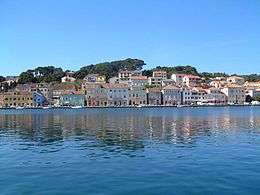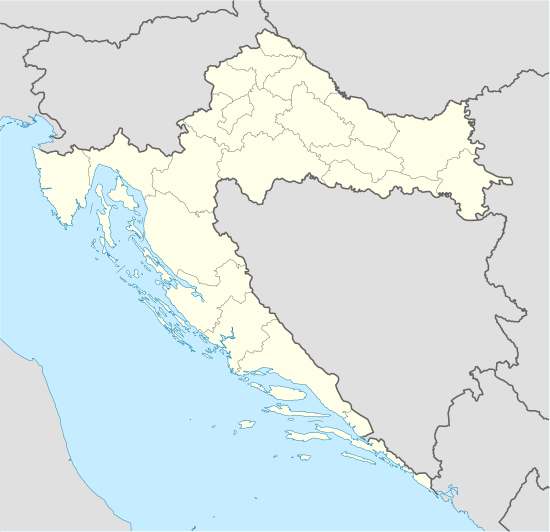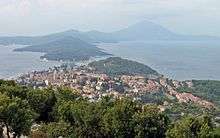Mali Lošinj
Mali Lošinj (Italian: Lussinpiccolo, Venetian: Lusinpicolo) is a town in the Primorje-Gorski Kotar County, on the island of Lošinj, in western Croatia. At the time of the 2011 census, there were 8,116 inhabitants, of whom 86% were Croats.[1]
Mali Lošinj | |
|---|---|
| Grad Mali Lošinj Town of Mali Lošinj | |
 Mali Lošinj port | |
 Mali Lošinj Location of Mali Lošinj within Croatia | |
| Coordinates: 44°32′N 14°28′E | |
| Country | |
| County | |
| Island | Lošinj |
| Government | |
| • Mayor | Ana Kučić (HDZ) |
| Elevation | 0 m (0 ft) |
| Population (2011) | |
| • Total | 8,116 |
| Time zone | UTC+1 (CET) |
| • Summer (DST) | UTC+2 (CEST) |
| Postal code | 51 550 |
| Area code(s) | 051 |
| Website | mali-losinj.hr |
The favourable climatic conditions, the construction of hotels and resorts, foresting and maintenance of beaches have led to an intensive development of tourism. The town is located in the most protected part of the Lošinj bay, on the eastern, sunny side of the island.
History

The town was first mentioned in 1398, under the name Malo selo ("small village"). In 1868, it experienced its golden year. There were as many as eleven shipyards, and it became the place with the largest and most developed merchant marine in the Adriatic Sea, even ahead of cities like Rijeka, Trieste and Venice. American author Kenneth Roberts observed that the little town, like some in southern Maine, seemed to have "produced a hundred seamen for each one produced elsewhere." Writing in 1938, Roberts said there were currently "four hundred sea captains living on Lussinpiccolo, which is about the size of Monhegan Island- captains of all sorts of vessels, from thirty thousand ton liners to hundred ton merchant brigs."[2]
With the invention of the steam engine a stagnation in development ensues, and with the outbreak of the grapevine-disease peronospora. Previously part of the Venetian Republic, Mali Lošinj passed under Austrian-Hungarian rule in 1797 with the Treaty of Campo Formio. The isle remained under Austrian-Hungarian rule until 1918. After World War I, under the provisions of the Treaty of Rapallo it was given to the Kingdom of Italy. In 1947, it was incorporated into Yugoslavia. Its incorporation into socialist Yugoslavia led to mass emigration of the Italian population. After World War II there were only 2,200 residents left. In 1991, it became part of present-day Croatia.
Climate
| Climate data for Mali Lošinj (1971–2000, extremes 1961–2014) | |||||||||||||
|---|---|---|---|---|---|---|---|---|---|---|---|---|---|
| Month | Jan | Feb | Mar | Apr | May | Jun | Jul | Aug | Sep | Oct | Nov | Dec | Year |
| Record high °C (°F) | 17.4 (63.3) |
20.4 (68.7) |
23.3 (73.9) |
26.1 (79.0) |
34.5 (94.1) |
35.6 (96.1) |
36.3 (97.3) |
37.4 (99.3) |
32.4 (90.3) |
29.2 (84.6) |
23.1 (73.6) |
18.9 (66.0) |
37.4 (99.3) |
| Average high °C (°F) | 10.2 (50.4) |
10.7 (51.3) |
13.2 (55.8) |
16.3 (61.3) |
21.3 (70.3) |
25.2 (77.4) |
28.4 (83.1) |
28.4 (83.1) |
24.2 (75.6) |
19.6 (67.3) |
14.6 (58.3) |
11.4 (52.5) |
18.6 (65.5) |
| Daily mean °C (°F) | 7.9 (46.2) |
7.9 (46.2) |
9.9 (49.8) |
12.8 (55.0) |
17.4 (63.3) |
21.2 (70.2) |
24.1 (75.4) |
24.0 (75.2) |
20.3 (68.5) |
16.4 (61.5) |
12.0 (53.6) |
9.2 (48.6) |
15.3 (59.5) |
| Average low °C (°F) | 5.9 (42.6) |
5.8 (42.4) |
7.5 (45.5) |
10.0 (50.0) |
14.2 (57.6) |
17.8 (64.0) |
20.6 (69.1) |
20.7 (69.3) |
17.5 (63.5) |
14.1 (57.4) |
10.0 (50.0) |
7.3 (45.1) |
12.6 (54.7) |
| Record low °C (°F) | −6.7 (19.9) |
−4.4 (24.1) |
−3.8 (25.2) |
2.9 (37.2) |
6.3 (43.3) |
9.7 (49.5) |
12.7 (54.9) |
10.0 (50.0) |
9.7 (49.5) |
5.0 (41.0) |
1.1 (34.0) |
−5.2 (22.6) |
−6.7 (19.9) |
| Average precipitation mm (inches) | 75.0 (2.95) |
69.4 (2.73) |
66.1 (2.60) |
69.2 (2.72) |
59.5 (2.34) |
67.9 (2.67) |
30.9 (1.22) |
57.0 (2.24) |
105.7 (4.16) |
109.1 (4.30) |
125.1 (4.93) |
95.8 (3.77) |
930.5 (36.63) |
| Average precipitation days (≥ 0.1 mm) | 10.1 | 8.4 | 9.3 | 10.3 | 10.0 | 8.3 | 5.4 | 6.0 | 8.6 | 10.0 | 11.3 | 10.4 | 108.3 |
| Average snowy days (≥ 1.0 cm) | 0.3 | 0.2 | 0.0 | 0.0 | 0.0 | 0.0 | 0.0 | 0.0 | 0.0 | 0.0 | 0.0 | 0.0 | 0.5 |
| Average relative humidity (%) | 74.1 | 70.6 | 70.9 | 70.8 | 70.7 | 67.9 | 63.5 | 65.6 | 71.2 | 72.7 | 72.8 | 73.5 | 70.4 |
| Mean monthly sunshine hours | 108.5 | 158.1 | 182.9 | 216.0 | 282.1 | 315.0 | 356.5 | 325.5 | 246.0 | 182.9 | 114.0 | 99.2 | 2,586.7 |
| Percent possible sunshine | 40 | 53 | 53 | 56 | 64 | 71 | 79 | 77 | 67 | 56 | 43 | 39 | 61 |
| Source: Croatian Meteorological and Hydrological Service[3][4] | |||||||||||||
Mayors
| № | Name | Term of office | Political Affiliation | |
|---|---|---|---|---|
| 1 | Mario Hofmann | 1991 | 1993 | HNS-LD |
| 2 | Dragan Balija | 1993 | 2005 | PGS |
| 3 | Gari Capelli | 2005 | 2016 | HDZ |
| 4 | Ana Kučić | 2017 | Incumbent | HDZ |
See also
References
- "Population by Ethnicity, by Towns/Municipalities, 2011 Census: County of Primorje-Gorski kotar". Census of Population, Households and Dwellings 2011. Zagreb: Croatian Bureau of Statistics. December 2012.
- Roberts, Kenneth (1938). Trending Into Maine. Little, Brown Co. p. 165.
- "Mali Lošinj Climate Normals" (PDF). Croatian Meteorological and Hydrological Service. Retrieved 2 December 2015.
- "Mjesečne vrijednosti za Mali Lošinj u razdoblju1961−2014" (in Croatian). Croatian Meteorological and Hydrological Service. Retrieved 3 December 2015.
Further reading
- "Lošinjska plovidba". Tehnička enciklopedija (in Croatian). Miroslav Krleža Institute of Lexicography. Retrieved 21 July 2020.
